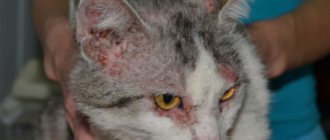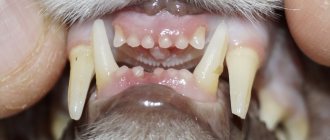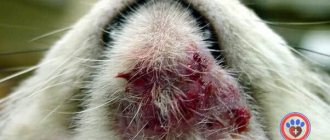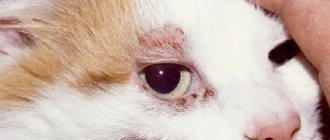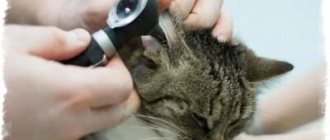Alena Igorevna Goncharenko
veterinarian Petstory
Skin diseases in cats are very common in veterinary practice. Such patients account for at least 30% of all types of visits to the clinic for help. To describe the condition of a pet's skin, owners usually use popular terms such as “sores,” “scabs,” “wounds,” and “ulcers.” In this article we will use the same terms for a better understanding and try to figure out why such problems arise and how to deal with them.
The main symptoms and manifestations of skin diseases in cats
Many skin diseases can present with very similar symptoms. You can often see bald patches, wounds, and scabs on the animal’s body. But some diseases have distinctive features, which, when seen, can make a preliminary diagnosis.
- Bald lesions on a cat's body can be found with lichen and demodicosis.
- A large number of scales similar to dandruff are observed when infected with the Cheyletiella mite.
- Wounds with crusts in the scalp area are noted with itching, which is often due to allergies.
- Skin ulcers on a cat's body can be found due to deep skin infection, thermal or chemical burns.
- Black spots on the chin are a sign of feline acne.
- Small crusts on a cat’s skin may indicate miliary dermatitis, which is how the cat’s body reacts to an infection or allergen.
- Pimples with white contents can occur with autoimmune diseases or superficial bacterial infections.
Non-parasitic
Non-parasitic diseases include skin lesions such as acne, eczema and bedsores. The difference between non-parasitic infections and parasitic ones is that they are not transmitted to humans or other animals and arise solely as a result of exposure to external irritants.
Acne
This is a bacterial inflammation of the sebaceous glands. The reason for this is a weak immune response. The main symptom is purulent pimples or blackheads located throughout the animal’s body. Treatment consists of using tar soap or anti-dandruff shampoo, and then treating the affected areas with antiseptics such as Miramistin. Sometimes the use of local antibiotics (Mupirocin) is required.
Eczema
It most often occurs in cats with very sensitive skin. The reasons are various injuries and damage to the skin, hormonal imbalances.
Typical symptoms include:
- rash;
- severe itching;
- irritation;
- blisters on the body;
- increased body temperature.
Over time, the wounds begin to peel off and then turn into weeping, purulent wounds.
Treatment consists of using soothing ointments, creams, gels and powders (Vishnevsky ointment, zinc ointment, Lassar ointment). Antiseptics should be used before applying the ointment. In advanced cases, the use of antibiotics may be required.
Bedsores
Appear after a long period of lying and immobility of the animal. Often affects pets in the postoperative period or paralyzed cats. It appears in those places that are in direct contact with the surface. It is important to follow preventive measures (lubricate parts of the body touching the surface with camphor alcohol). Levomekol ointment is used for treatment.
Diagnostics
A preliminary diagnosis can only be made based on the results of the examination, since the diseases have characteristic clinical signs described above. Additional studies are required to confirm the diagnosis. To exclude the presence of a bacterial or fungal infection, a cytological examination of skin smears is performed. Also, thanks to it, you can see the cells that appear in autoimmune diseases. Autoimmune disease is confirmed using skin histology. Using scrapings, in most cases it is possible to detect skin mites, but the Demodex gatoi mite is very rarely found in scrapings, and this disease is not easy to diagnose. Several methods can be used to diagnose lichen. First, the animal is examined under a fluorescent lamp - this method makes it possible to detect lichen in 50% of cases, since not all types of this infection will glow under the lamp. Then trichoscopy can be performed, thanks to which you can see the hairs destroyed by fungal spores. A more accurate diagnosis is to inoculate hairs in special growth media. Fungi in such environments can grow for a long time, up to 3-4 weeks, but the accuracy of this diagnosis is at least 95%.
Most often, identifying an allergen is not an easy task; there are no special tests for this. First, using scrapings, cultures, etc., it is necessary to exclude all possible differential diagnoses, which will be suggested by the doctor. If allergy remains the most likely diagnosis, the stage of excluding possible allergens will begin. First of all, fleas are excluded, the animal and the room where it lives are treated. A special elimination diet may then be prescribed to rule out food allergies. If the allergen is not identified, a diagnosis of “non-food allergy” or “atopy” is made.
Allergic reactions
Quite often, cats experience allergic reactions of various origins. The most common are household, food and drug allergies. It manifests itself most often in the form of dermatitis. In localized areas, the fur usually thins out or falls out completely, and itchy areas appear, which causes great discomfort to the animal. The symptoms and treatment of various forms of allergic reactions are usually the same. In most cases, antihistamines are prescribed. But the most important thing is to identify which substance is the allergen and eliminate it.
Atopic dermatitis
Atopic dermatitis is a disease of an allergic nature. Usually caused by various external factors - dust, detergents, pollen. Its signs are progressive baldness in the neck, ears, abdomen or between the thighs, irritation and ulcers on the skin, itching.
The disease is treated with broad-spectrum antimicrobials and antihistamines.
Miliary dermatitis
Miliary dermatitis, in most cases, is also of an allergic nature, although it can occur as a result of bacterial, fungal infection, helminth infection, hormonal or autoimmune disorders.
It can be recognized by a finely nodular itchy rash and active hair loss in areas where the skin is affected.
The diagnosis and cause of the disease are determined during a comprehensive examination: scrapings are taken from the surface of the skin, and a laboratory analysis of the hair is performed. If this is not enough, the doctor may prescribe a skin biopsy.
Treatment is prescribed based on the results of the diagnosis. The cause of the pathological reaction of the body is eliminated and supportive therapy is prescribed.
Feed intolerance
A food allergy can occur when a pet is switched to a different diet. This form of the disease is characterized by both skin and gastric manifestations - urticaria, nausea, vomiting, loose stools. Sometimes there are symptoms of eosinophilic granuloma - nodular formations in the lips and mouth. If no measures are taken, anaphylactic shock may develop.
Treatment of skin diseases in cats
If bacterial or fungal flora is detected in the affected areas of the body, local and systemic drugs, various antibiotics and antifungal agents are prescribed. If the cat is good at washing, bathing with antibacterial shampoos is convenient. Skin mites are treated with antiparasitic drugs. Recently, modern preparations in the form of drops on the withers have been used for this; they are highly effective. Autoimmune diseases are treated with drugs that suppress the immune system - immunosuppressants. Such drugs can be prescribed either as a course or on an ongoing basis. To treat allergies, it is necessary to identify the allergen and eliminate it from the animal’s life. But this is not always possible. Otherwise, drugs against itching and inflammation are used. If your pet's allergies are seasonal, then the tablets should be taken only during the period of exacerbation. If the allergy is constant year-round, then the drugs will have to be used for life, trying to choose the minimum effective dosage. To treat psychogenic itching, sedatives and antidepressants are used.
Recommendations for nutrition during the recovery period
Cat nutrition during a difficult period of recovery and rehabilitation should have an integrated approach. It must be remembered that a cat is a predator by origin.
Complete dry and wet food should correspond to the natural needs of the cat, its characteristics and history, take into account its dermatological problems and laboratory tests, depending on the specific case. The diet should be high in protein and contain polyunsaturated fatty acids omega-3 and omega-6, found in fish, which enhance the protective functions of the skin and accelerate healing.
The special needs of pets with skin and coat problems are taken into account in Purina® PRO PLAN® NUTRISAVOUR® Derma Plus complete wet food and PRO PLAN® Elegant Adult dry complete food for adult cats. The diets support healthy skin and a beautiful coat thanks to the content of high-quality protein, vitamin E and omega-6 fatty acids, zinc. In addition, they reduce excessive hair loss, support healthy digestion by controlling the formation of hairballs, and help hair move smoothly through the digestive tract.
During the recovery period, the cat needs special care and attention. It is important to maintain the indoor microclimate, sufficient air humidity and lighting, the cat’s activity and its psychological state.
Getting rid of dermatological problems should be approached comprehensively from different angles, and then the result will not keep you waiting!
Prevention
The main methods of preventing skin diseases in cats include regular antiparasitic treatments. Using drops on the withers, even for domestic cats, allows you to avoid many unpleasant situations associated with infestation with fleas and ticks. The contact of a domestic cat with stray animals should be limited. It is necessary to organize the pet’s living environment in such a way that it does not need anything and does not experience chronic stress. Stress can lead not only to psychogenic itching, but also to a decrease in the overall immunity of the body.
Causes
Skin pathologies can bother cats temporarily, for example, arising when changing food and spontaneously stopping when returning to a normal diet. But much more often, pets are worried about seasonal diseases associated with increased activity of skin parasites. The most common causes of skin diseases are:
- ectoparasites - fleas, ticks lead to the occurrence of dermatitis, sarcoptic mange, notoedrosis, otodectosis;
- fungal infections cause lichen;
- improper care can cause an allergic reaction, acne, eczema;
- abnormalities in the development of sebaceous glands and hair follicles also cause acne;
- allergies, stress, injuries, kidney diseases, tumors, diabetes mellitus lead to bacterial infections of the skin;
- psychological disorders can cause baldness (alopecia);
- diseases of the internal organs (stomach, liver, kidneys) provoke eczema.
Can a person get infected from a cat?
Most skin diseases in cats are not transmissible to humans and are only contagious between felines. Ringworm is potentially contagious to humans, and children, the elderly and people with weakened immune systems are considered especially vulnerable. Adults most often do not become infected from cats. If you notice signs of lichen, you should immediately consult a dermatologist. Notoedrosis can cause pseudoscabies in humans, but the disease itself does not require treatment.
Ways of spreading fungal spores
Well, we previously looked at the introductory information that describes the concept of ringworm. In addition, we paid special attention to factors that contribute to rapid infection . But how does the process of disease progression occur? Is it possible to warn yourself and your pet?
Previously, we have already drawn the attention of readers to the sources of damage. Ringworm in cats is formed due to direct contact with fungal spores, characterized by microscopic sizes. It is almost impossible to record the presence of dispute data without any professional equipment. Microsporia, like, strictly speaking, trichophytosis, is rightfully considered an extremely common disease, occurring in both street and domestic animals. Veterinary service specialists currently identify 4 channels of infection:
- direct contact with an affected individual;
- indirect contact through personal objects of the affected individual;
- spread of spores by rodents;
- transfer of fungal pathogens on clothing.
The list presented above clearly demonstrates all the ways spores can spread. It is worth noting that the pathogens themselves are characterized by high resistance to external factors. In this regard, they can be active over a fairly long period of time. Transmission of the disease from cat to human is not recorded so often. In most cases, only preschool children and adults who, due to certain reasons, have weak immunity, are exposed to damage processes. A healthy human body prevents the development of the disease by effectively suppressing the activity of fungal pathogens.
But what to do if an infection occurs? What does ringworm look like in cats and how can it be recognized? We will try to present the results of studying these issues in the next section devoted to the symptoms of the disease.
Hereditary and acquired alopecia
Congenital alopecia is the absence of fur in a newborn kitten. In the future, hair will not appear. Such cats suffer from thermoregulation disorders, easily get skin injuries, scratch and scratch themselves. But this same pathology became the basis for hairless breeds.
Acquired alopecia develops as a consequence of other diseases. Most skin pathologies in cats cause hair loss. If the disease is accompanied by itching and the animal is constantly itching, then the process of hair loss accelerates. There is also alopecia of unknown origin, when the cause of hair loss cannot be determined.





